Mirror of Hope
Mirror of Hope
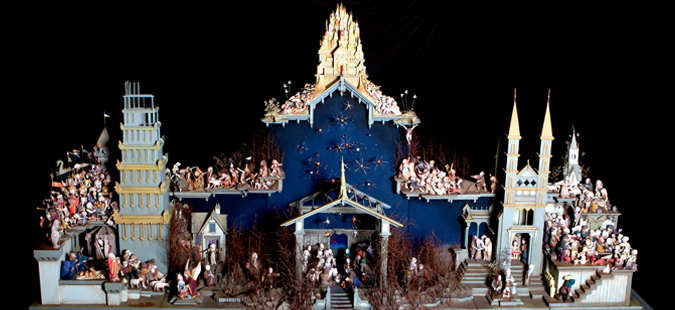
Central to the Mirror of Hope is a classical symbol of salvation—the mountain. The Mountain of Salvation became very popular during the Baroque period and replaced other symbols of salvation such as the Mirror of Human Salvation and the Bible of the Poor of the Middle Ages. The mountain is a universal and biblical symbol of divine revelation and sacred space—the juncture between heaven and earth and the place of encounter with God. Within Hanna's presentation of a mountain is a circular movement—a cycle of love. It is the narrative of God's love for his creation and humanity's response. On the left, there is a descent representing the creation of the world and the history of civilization seen as a combination of God's gracious gifts and human resourcefulness. Here we have a descending movement. The base and right flank of the sculpture suggest an ascending movement. It represents the story of redemption: beginning with the promise to Abraham and Mary, leading from Bethlehem to Cana and to Calvary, and taking the people of God back to the point of departure and fulfillment on the mountain's top. Here again, it is suggested that God's work is not achieved without human participation. The latter aspect, human participation, is best illustrated with the discreet but active presence of the figure of Mary in most of the scenes picturing Jesus' life and that of his followers.
This sculpture is built and organized around four cardinal points or architectural structures. We see on top what biblical tradition calls the City on the Mount, to the left the tall but sturdy Tower of Babel, at the bottom and center of the mountain the wide open Stable of the Nativity, and to the right the elegant steeples of the Temple-Cathedral.
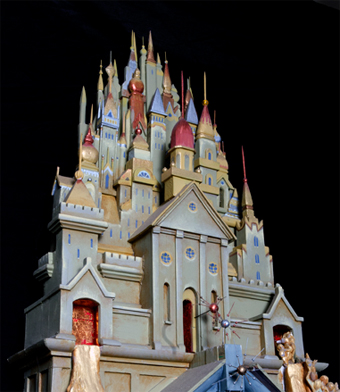
The City on the Mount
With its golden towers, steeples, and spires, the City on the Mount is a symbol of God's presence and of abundant goodness. It is the ultimate point of reference for the meaning of human existence, the Alpha and Omega embracing creation and redemption. The City on the Mount or Heavenly Jerusalem is the cradle of human life and also its destiny. In the medieval tradition, works of art included some faces or objects familiar to the audience. In the skyline of this work is the silhouette of the University of Dayton's Chapel, flanked by its two gates. This artistic device well indicates that salvation is not past and distant, but always a concrete, local, personal and communitarian endeavor. It occurs here and now.
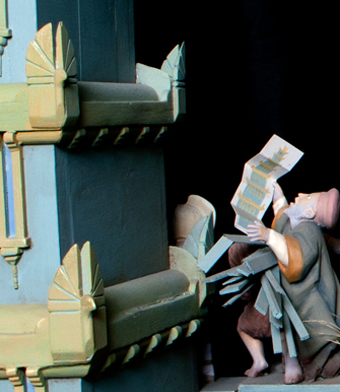
The Tower of Babel
The Tower of Babel is a sign of contradiction. It is, on the one hand, an impressive monument representing human effort and achievement. The history of human civilization is not separate from salvation. All our striving toward the good is a contribution to full redemption. However, the tower of Babel is also a monument of human hybris, of refusal and rejection. Its architects are no longer inspired by the light that comes from the mountain top. They have mapped the world according to their own standards and ignored the more fundamental design of God's creation. Thus, the tower of Babel remains incomplete, it is an unfinished structure in the landscape of redemption.
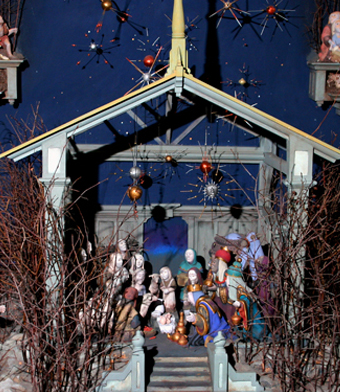
The Stable of the Nativity
The stable of the Nativity stands between the Tower of Babel and the Cathedral, at the center of the Mountain of Salvation, directly below the City on the Mount. It is showered with the light of the sun and the stars from the mountain top. The stable is open on all sides: in front and behind, right and left, and on top. Incarnation is a permanently open house. Invitation goes out to everybody; salvation is available to all. The stable of the Nativity is a halfway house: the mystery of incarnation is meaningful only if we neither reject nor domesticate God, that is, if we accept the sometimes tenuous position between the tower of Babel and the cathedral. On the other hand, there exists a direct line, a real lifeline, between the glory of the City on the Mount and the infant in the drafty house of Bethlehem. Visually speaking, salvation is rooted in the complementarity of these two images: it comes to us from the mountain top. It is a gift of God's generous love, but it needs to be enfleshed in human reality and cared for with holy realism. The Mountains of Salvation frequently have a Nativity scene at their base and center. The meaning is this: Salvation has cosmic dimensions. It permeates all layers of human and natural reality, from top to bottom. God assumes the totality of his creation.
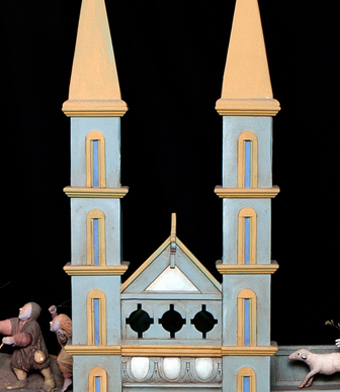
The House of God
A recurring temptation in Christian history is to believe that God can be completely accommodated to human categories, sometimes even to the point of making God a prisoner of beautiful palaces and cathedrals. Deus semper major: God transcends human scheming. Only a God free to love can be a true redeemer. In this sculpture, Jesus, his mother and his disciples bypass the imposing structure of the cathedral. This is one way of indicating that cross, passion, death and resurrection lead us beyond the narrow confines of organized religion. But this is only part of the message the temple-cathedral structure conveys. God's grace comes in earthen vessels, in the middle of the assembled Church. It is we who give a home to God's message and presence. The temple-cathedral then is a reminder that Christian salvation has both a long personal and collective history. Every church is a memorial in stone of the continuous effort to understand and cherish the message of salvation.
Take a Video Tour
Watch and listen as Marian Library docent, Ann Persensky, points out the many meaningful details in the Mirror of Hope.
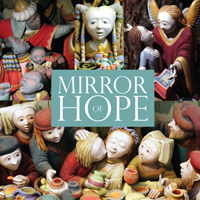
This 110-page book is filled with large photographs that enhance the smallest details in the structure. You will be introduced to the artist, Kevina Hanna, and to his creative processes. You will travel through the Mirror of Hope piece-by-piece and scene-by-scene experiencing the story of salvation history.
Author: Johann G. Roten, S.M. | Photography: Robert B. Breen | Design: Ann E. Zlotnik
Printer: Meyers Printing and Design, Dayton, Ohio, 2012
All About Mary includes a variety of content, much of which reflects the expertise, interpretations and opinions of the individual authors and not necessarily of the Marian Library or the University of Dayton. Please share feedback or suggestions with marianlibrary@udayton.edu.
